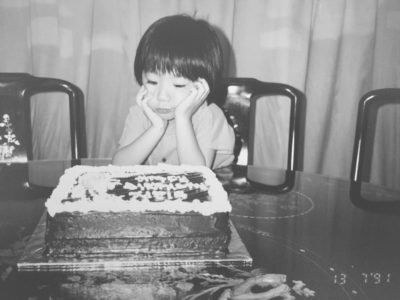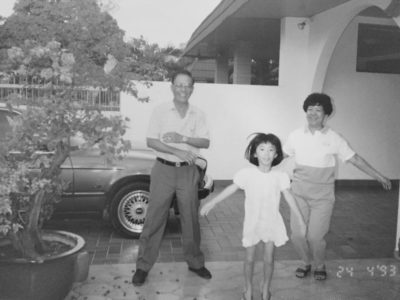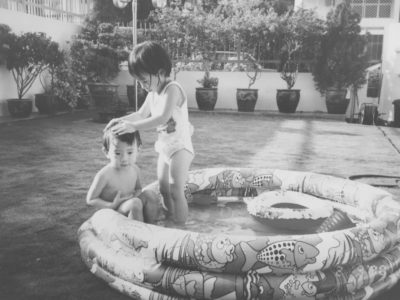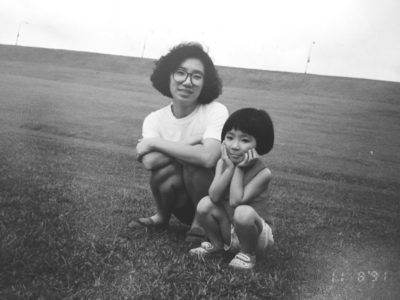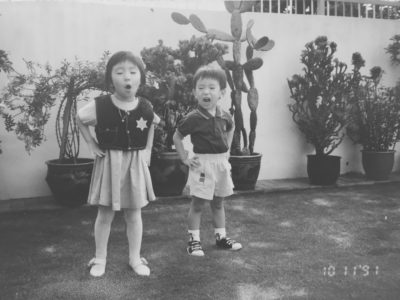Our Daughter, the Artist
February 20, 2019
Text by Hue Boey Kuek with input from Say Cheong Ng
To get the long view of an artists career and work, we asked the parents of Xi Jie Ng to offer us some insights. Xi Jie offers an introduction, and questions were prepared by Spencer Byrne-Seres.
I once shouted at my father through sobs on our porch, “Trying to live your dreams is the most practical thing you can
do in life!” and told him to read his Dalai Lama book on happiness. Two years before that, my father demanded to know my “plan b and c” when I quit my arts administration job to be an artist. Today, external institu- tional validation and experiencing my and my peers’ work have helped my parents bet- ter understand their eccentric firstborn and what it means to have a creative practice. I think they choose to see a certain side of my work in a somewhat do-gooding light; that is grand progress for us. Say Cheong is known to be an enthusiastic, task-oriented eager-beaver; he once went up to my high school theatre studies teacher and told him, “I’m worried about her. She’s coming up with weird names for herself.” Hue Boey is a hardworking, empathetic worrier-type; she encouraged my childhood love for crafts, drama and reading. Both grew up poor in developing Singapore, are now financial- ly worry-free and have never changed their civil service jobs. Putting myself in their shoes with a lot of grace (as is often need- ed in familial interactions), I see how it is terrifying that my work may challenge state control and that my life might manifest in patchwork ways wildly different from the safe, hammered-into-the-cultural-psyche Singaporean standard. But which child doesn’t yearn for profound understanding, acceptance and support (in that order) from their parents? I think a lot about karma and why we are born to our parents. Recently, my mother told me I am resourceful and suited to this crumbling world, that as a result of me, she and my father experience things they usually do not. This can mean putting on a new lens – as she wrote, to my infinite delight, “Many of the things we do, even in everyday live, is art, for example, cooking a dish, arranging furniture or deco- rating our house, gardening, sewing, writing, etc.” I am deeply grateful for their sup- port through confusion, and that my artistic practice is now, for us together, a portal into my cosmos and many more worlds that may rightly excite, shock and abhor them as they age.
-Xi Jie Ng
When did you know your daughter was going to be an artist? What were the signs? How did you feel, knowing this was her chosen path?
Xi Jie had shown a lot of creativity since young. She also enjoyed activities like drawing, art & craft and speech and drama classes. Birthday presents for some family members were always very interesting creations of hers. When she started pursuing theatre studies in junior college, that was the start of more serious pursuit of her interest in creative work. She surprised us by her projects which were out of the ordinary. After graduation, she took on a job in the National Arts Council where she organised the first silver arts festivals (for seniors) in Singapore. Her ideas of getting seniors to appreciate and participate in creative activities were very novel. She also embarked on projects like filming which showed her other talents. She went on to do other projects. We saw that there was no limit to what she is capable of and there was no doubt she would continue to pursue her interest in the arts.
We were at first a bit concerned that she was not taking the conventional path like other kids. We felt that it was a waste of her talents – she was good in both the arts and sciences subjects, including mathematics. She is intelligent and we were sure she could excel in the more conventional route. Like many parents who would like their children to have a secured future, we were concerned if she could make a living being an artist. Despite our reservations, we continue to support her.
How are artists viewed in Singapore in general?
Our sense is that there is greater understanding and appreciation of artists and their work in Singapore especially by the younger population and post-baby boomers given they are mostly educated and also more exposed to art through today’s very borderless world and greater appreciation of things beyond the science of things and materialistic pursuits.
How would you describe Xi Jie’s work? What type of artist is she? How is her work different or unique from other artists?
As amateurs in the field of art, we think that Xi Jie’s works is very varied. This reflects her multi-talents and versatility. Her work covers drawing, illustrations, writing, producing films, acting, photography, installations, etc.
What stands out about some of Xi Jie’s work is that they seem to originate from her interest in people and things of the past. For instance, capturing the daily lives of her grandmothers in film, telling the story behind Singapore’s pioneer busker in film, an exhibition on bunions which is a body defect affecting many people, getting seniors to go beyond their limits to come up with creative art and craft, working with prisoners on art projects, etc.
Some of her work is abstract and we could not immediately grasp the message behind them. Examples include her work at a few residency programmes. One of these is a picture of her against the moon that she took at a residency in Finland. Another is a project she did in Elsewhere (North Carolina) where she created a space like a Japanese capsule hotel.
How does watching Xi Jie’s work make you feel?
Xi Jie’s works have opened our eyes and at times make us feel that she lives in a different world from what we are used to. Our background is in engineering and science and our thinking is very black-and-white. We have been prepared to enter her world and experience it. Our visit to Portland in 2017 had given us the opportunity to experience her projects which we were amazed with.
What have you learned from Xi Jie’s work? Has Xi Jie’s work challenged you, or changed your views on anything?
Needless to say, it has challenged us to be very open to artistic work and to appreciate that the work has meaning to the artist behind it that we should never discount or even laugh at. The more abstract the work is, the more we have to challenge ourselves.
We learnt from Xi Jie’s work about limitless imagination, of making connections with things, people and between them and seeing meaning beyond what our eyes and our mind typically tell us. We also learnt that there is innate potential of artistic work in everyone. Many of the things we do, even in everyday live, is art, for example, cooking a dish, arranging furniture or decorating our house, gardening, sewing, writing, etc.
What is your favorite project that Xi Jie has created? Describe the project and how you engaged with it – were you a participant, saw it at an event, saw documentation (photos and videos taken of the project) ?
Our favourite project is the short film about the daily lives of her grandmothers. We are delighted that she takes an interest in how her grandmothers are spending their silver years and wants to document it in a film. The film also gives audience a glimpse into the lives of the ordinary grandmother in Singapore.
We were not involved in the filming but got updates from her. The grandmothers were as expected, accommodating. We are sure that Xi Jie learnt something more about her grandmothers through the project, for example, her maternal grandmother attended dancing class.
What is one project or artwork you wish Xi Jie would do, that she hasn’t done?
Her father hopes that she can do a project to get the community’s support for creative art for seniors. The Silver Art Festival was a good start and it is now an annual event. WIth an aging population, there are opportunities to engage more seniors in art activities that they can enjoy.

